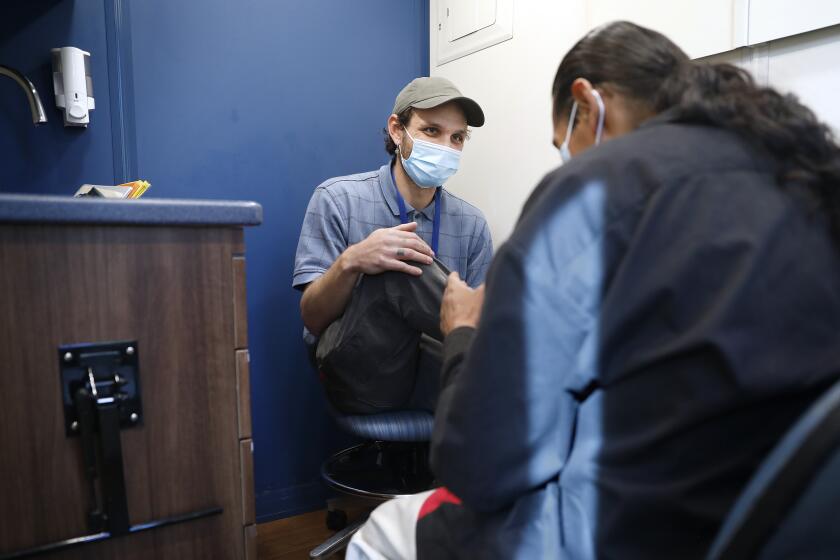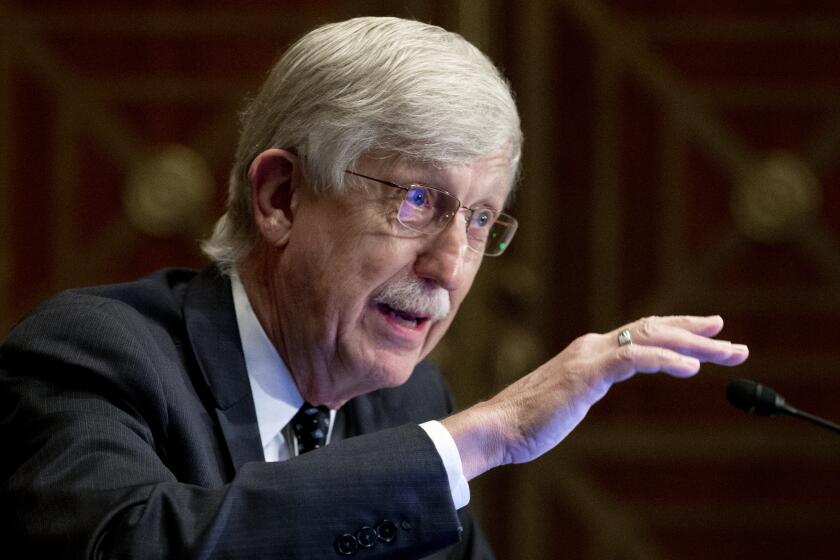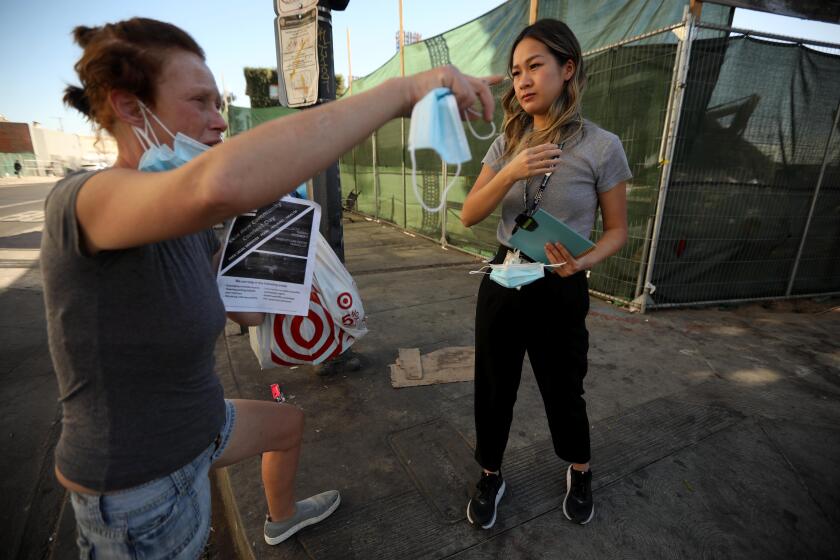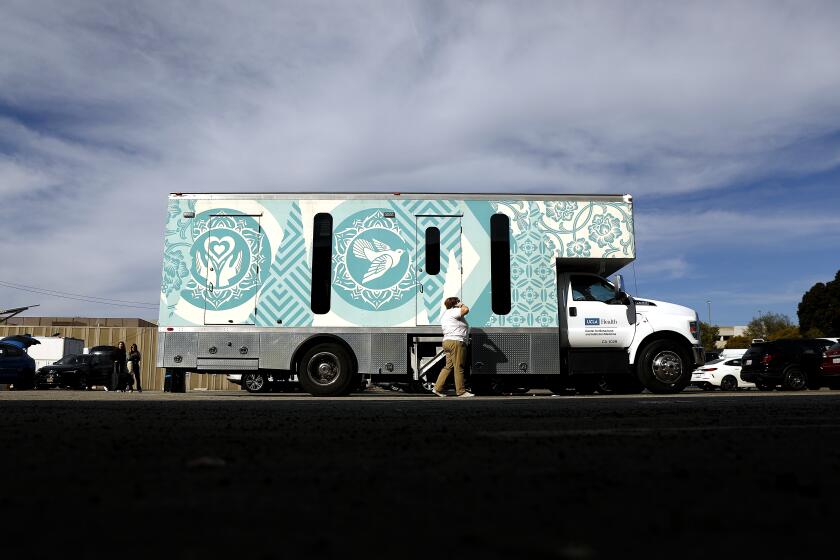Why L.A.’s battle against a deadly disease relies on unpaid volunteers
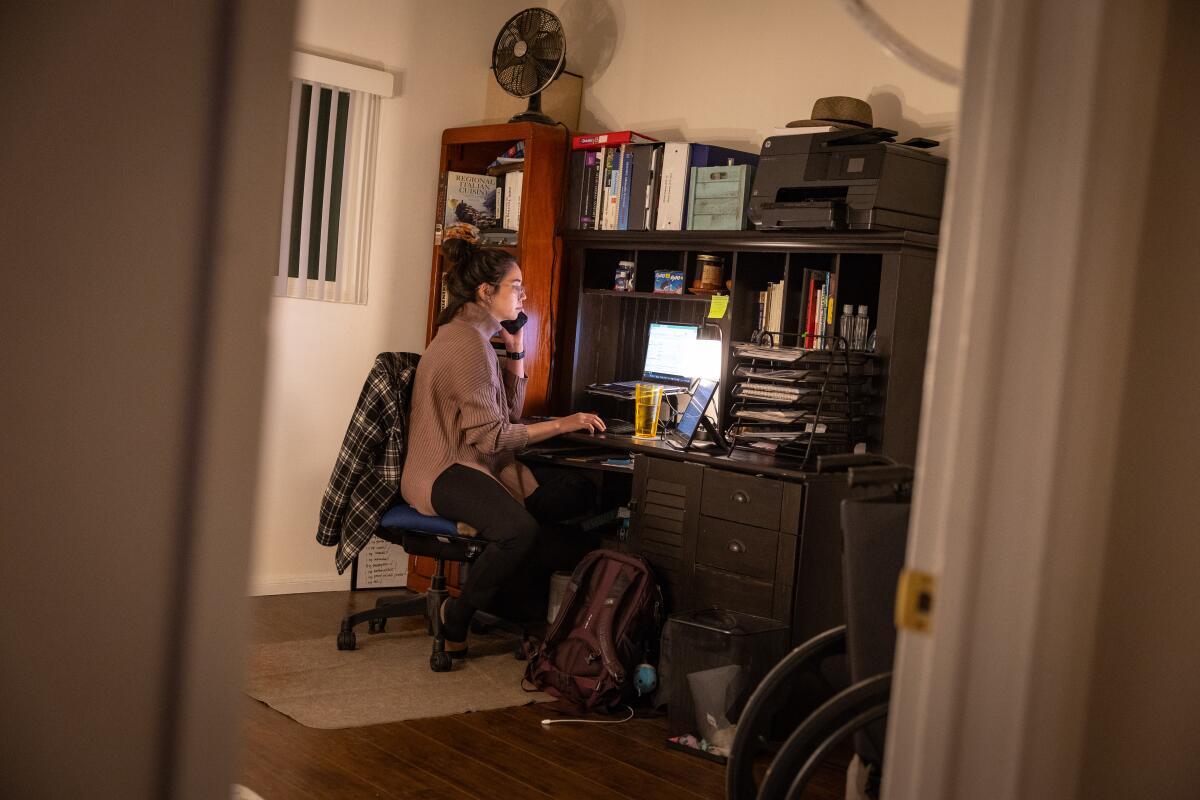
- Share via
As evening fell in her Glendale apartment, Dara Bruce fed her pet rats George and Fred, poured herself a glass of water, and dialed a complete stranger to discuss the dangerous virus detected in his blood.
“Is now a good time to talk?” she asked.
Bruce is a volunteer in the enduring fight against hepatitis C. The stealthy killer claims the lives of roughly 14,000 Americans each year, even though it can be readily cured with a few months of pills. Many people have no idea they are infected, going years without symptoms before the blood-borne virus devastates the liver.
Yet public funding to combat hepatitis C is so scant that in Los Angeles County — an area more populous than many states — the crucial work of contacting those who are infected is being done by unpaid emissaries like Bruce through a fledgling initiative called Project Connect.
A partnership between USC and the county public health department, Project Connect trains volunteers to call people who have tested positive for the virus to make sure they know their results and encourage them to get the medication they need.
Sitting behind her desk lined with anatomy textbooks — the artifacts of the master’s degree in integrative anatomical sciences that she had just earned from USC — Bruce double checked that she had the right person before giving him the news. His reaction made her brighten.
“Oh, beautiful!” she exclaimed after the man told her he had been treated. “I love to hear that.”
It isn’t something she hears a lot. Among those contacted by Project Connect through mid-January, less than a third had been treated. That echoes the dismal statistics across the U.S., where only about a third of people who test positive start treatment within a year.
Across the country, the number of new hepatitis C infections reported annually more than doubled between 2014 and 2021, topping 5,000. That same year, more than 107,000 longtime infections were newly discovered, according to federal data.
Hepatitis C can now be cured in most cases with antiviral medication. Yet in the U.S., only a fraction of people who are found to be infected promptly start treatment.
Some untreated infections may clear up on their own, but many will endure, leaving people at risk of illness and death. People with long-term infections can develop cancer or end up with liver scarring so grave they need an organ transplant.
Experts say the high number of untreated patients is tied to obstacles such as doctors unnecessarily shunting patients to specialists and insurers making it difficult to obtain the pills, which can cost upward of $20,000. Many don’t realize they’re infected: One in six people reached by Project Connect volunteers didn’t know their test results.
The virus has taken an especially heavy toll on people who are often disconnected from health systems, including those who inject drugs or are unhoused. And many at-risk people are unaware of the threat, including baby boomers who were infected long before the virus had been identified.
Having an effective hepatitis C medication on the market isn’t enough to solve the problem, said Dr. Jeffrey Klausner, an infectious disease specialist at USC. It has to reach the patients who need it.
“You need people to be aware of their infection. You need people to be seen by a treating provider. You need people to get the medications prescribed,” he said.
The problem is that “this is a disease without resources,” said Dr. Prabhu Gounder, medical director of the viral hepatitis unit at the L.A. County Department of Public Health.
That’s a common complaint across the country. In a national survey conducted by hepatitis organizations, only 3% of local jurisdictions said they could make progress toward hepatitis elimination goals at the current level of federal funding.
“It’s incredibly dangerously underfunded,” said Anne Donnelly, a member of the California Hepatitis Alliance who works with the San Francisco AIDS Foundation.
The Biden administration is seeking billions of dollars for a new push to wipe out hepatitis C, a virus that kills thousands of people annually in the U.S.
The Biden administration has been pushing for billions of dollars to wipe out hepatitis C, arguing that the investment would pay off in the long run as Medicaid recipients avoid liver ailments that require costly care. An analysis released by the National Bureau of Economic Research found that the initiative would save the federal government more than $13 billion over a decade, exceeding its upfront costs.
Nobody in public health is unaware of “what needs to be done to address hepatitis C,” said Sonia Canzater, associate director of the Infectious Diseases Initiative at Georgetown’s O’Neill Institute for National and Global Health Law. “The problem has always been the resourcing and getting the political and the social will behind it.”
In Los Angeles, Gounder said budget limitations have made it impossible to roll out a sweeping program for people with hepatitis C.
But “what if we were to just give them a call and make sure that they’re aware of their infection? Provide some education?” Gounder wondered. “That alone is not going to solve this epidemic. But we thought that was a low-resource thing that we could do to try to move the needle.”
The result was Project Connect. It began in April, tasking volunteers with reaching roughly 3,000 county residents, and is now adding another 3,000 cases to its rolls.
Klausner said the project relies on the part-time efforts of five university staffers and anywhere from six to 12 student volunteers, many of whom need to log hours of field experience for graduate degrees in public health.
The public health department taught them the rules about patient privacy along with some basics on the virus and its treatment. The USC volunteers now devote at least four hours each a week to calling and texting people about their test results, relying on reports that come into the county after patients test positive.
Learning about the ongoing toll of the virus “fired me up,” said Bruce, a 36-year-old former aerial arts performer.
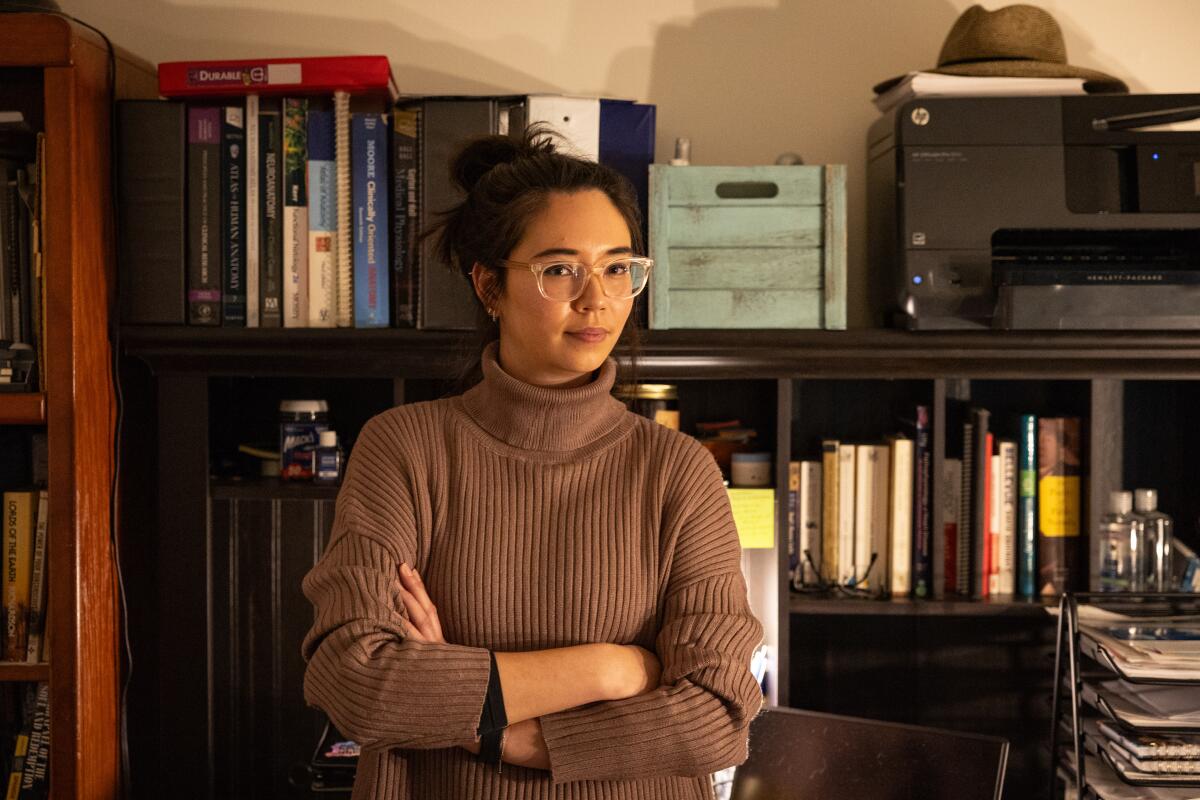
Her interactions with hepatitis C patients left her struck by “how prevalent it seemed to be across people from all different walks of life” — but also by the vast disparities in what had happened to people after they learned about their infections. “There were such different stories.”
Some people told her they wanted treatment but had no way to get to a doctor or couldn’t take time off work. There were also patients who didn’t feel a sense of urgency to get the pills, since it can take years for serious health problems to develop.
To them, it “just didn’t really seem like something they needed to get taken care of right now,” Bruce said.
More than 70% of the patients on volunteers’ lists can’t be reached, often because the phone numbers in their files were wrong. The team doesn’t have the resources to track people down in government databases or on the streets, the way that public health departments do for some other illnesses.
This L.A. County investigator is working to track down a crucial set of patients who have slipped away from the health system: Women of childbearing age who have tested positive for syphilis.
L.A. County’s public health department is not spending any of its own money on Project Connect, relying entirely on the USC volunteers and some support from county employees. Hiring a small team to tackle such work would cost roughly $250,000, Gounder estimated — not a massive sum but “not feasible with the budget we have.”
His viral hepatitis team gets roughly $1.2 million in grant funding from the federal Centers for Disease Control and Prevention and the California Department of Public Health, but that must cover costs for hepatitis A and B as well as C.
In comparison, the county receives roughly $97 million in state and federal grants to address HIV. Gounder said funding for hepatitis C has been so scant that he cannot determine the exact number of cases in the county, but statewide estimates suggest it rivals or exceeds the number of HIV cases.
Both diseases can be deadly and put other people at risk of infection if left untreated. But the push to get antiretroviral treatment to HIV patients was bolstered by “an incredibly active community” that included wealthy people, said Dana Goldman, dean of the USC Sol Price School of Public Policy.
The same kind of mobilization hasn’t happened for patients with hepatitis C, he said, but “that doesn’t mean they’re any less deserving.”
Hepatitis C can be cured in most cases with a few months of medication. The number of Medi-Cal patients getting the treatment dropped during the pandemic.
Relying on volunteers has its limits: Among other things, it means the work can be interrupted during university breaks or exam periods, Klausner said. And phone calls only go so far: Among the untreated patients Project Connect was able to follow up with after three months, only 20% had gotten the pills.
Klausner believes the county has a responsibility to fund paid staff. And he wants the outreach teams to be able to schedule people for treatment and assist them with transportation vouchers, child care or other aid — the “linkage to care” he said has been missing.
But Bruce said that even a phone call can be meaningful for those on the other end of the line. “This is about listening to people and their stories,” she said.
In her Glendale apartment, Bruce asked if the man on the phone had time for a few more questions. The answers would help officials get a clearer picture of who is getting treated and who is not.
“I’m glad you’re a success story for treatment,” she told him before wishing him good night.
Bruce called the next number, only to be hung up on. She called again and left a message with her phone number.
More to Read
Sign up for Essential California
The most important California stories and recommendations in your inbox every morning.
You may occasionally receive promotional content from the Los Angeles Times.
